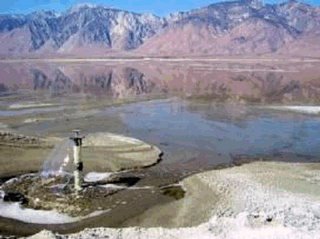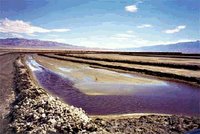
Los Angeles: An Oasis in the Desert-How is it possible?
This blog is about environmental sustainability as a pressing national and global issue being explored today. The death of many natural areas is taking quite a toll on the natural environment with compounding effects that domino into other areas of the ecological system.
I think that Angelinos today need to take a close look at where we get a majority of our water from, as it is not simply the Colorado River and it does not come without a cost to someone. The California Aquaduct runs from the Owens Valley to LA and over the last 10 years it has been responsible for transporting half of LA's clean drinking water to the city. It was designed and built by William Mullh
 oland, an immigrant from Ireland who completed the project in 1913. The century long withdrawl of this water however has had a large impact on the residents and local ecology in Owen's Valley leaving Owens Lake dry to the lakebed and sticking resident of the Owen's Valley with serious problems due to toxic dust storms swirling from the sediments resting on the exposed lakebed. Los Angeles Water and Power has set to work with a mitigation effort to protect the health of Owens Valley residents and visitors, but it comes at a great cost as this area has to be under constant monitoring and expensive mitigation systems must remain in place as long as the lake is dry.
oland, an immigrant from Ireland who completed the project in 1913. The century long withdrawl of this water however has had a large impact on the residents and local ecology in Owen's Valley leaving Owens Lake dry to the lakebed and sticking resident of the Owen's Valley with serious problems due to toxic dust storms swirling from the sediments resting on the exposed lakebed. Los Angeles Water and Power has set to work with a mitigation effort to protect the health of Owens Valley residents and visitors, but it comes at a great cost as this area has to be under constant monitoring and expensive mitigation systems must remain in place as long as the lake is dry.Best Available Control Measures
The MOA specified that the City must choose from amongst 3 control measures the GBUAPCD has certified as Best Available Control Measures (BACM) for Owens Lake. The 3 BACM are Shallow Flooding, Managed Vegetation, and Gravel. The first phase of dust control implementation, completed December 2001, consists of 13.5 square miles of Shallow Flooding.
Shallow Flooding
Shallow Flooding involves flooding the area to be controlled until it is either inundated with a few inches of water or the soil becomes thoroughly saturated to the surface with water.
 The second phase of dust control implementation, completed in July 2002, consists of nearly five square miles Managed Vegetation. Managed Vegetation involves growing native vegetative cover that will by hold the shifting and emissive lakebed in place, locking up the dust.
The second phase of dust control implementation, completed in July 2002, consists of nearly five square miles Managed Vegetation. Managed Vegetation involves growing native vegetative cover that will by hold the shifting and emissive lakebed in place, locking up the dust.Managed Vegetation
The third phase of dust control implementation, completed in March 2003, consists of one and a third square miles of additional Shallow Flooding.
Current Status
To date, the City has completed construction on approximately 19 square miles. Therefore, the city is nearly 2/3 complete with its obligation. Planning and design are currently underway for the additional 11 square miles to be specified in GBUAPCD’s revised SIP. An additional two to four construction phases are expected to meet these requirements. The Department of Water and Power is currently evaluating its budget for the program based on the GBUAPCD’s SIP.
Los Angeles also recieves water from the Mono Lake Basin. This began after WWII with the Mono B
 asin Project as a way of providing another reliable water source to LA. Simmilar problems have plagued Mono Lake due to the diversion of water from its tributaries to provide for LA's growing populations and water needs. Since 1941, the volume of water in Mono Lake has been halved while its salinity has doubled. Large toufas, interesting dried salt formations protrude from the blue waters as distinct markers of the ecological collapse the area is facing. Much work has been done through volunteer activism, citizens groups, government action and non-profit interventions. These groups have led a coalition to support the fight to protect Mono Lake with litigation, legislation and negotiation. The area while still threatened, serves as a hub for classes and environmental education to take place.
asin Project as a way of providing another reliable water source to LA. Simmilar problems have plagued Mono Lake due to the diversion of water from its tributaries to provide for LA's growing populations and water needs. Since 1941, the volume of water in Mono Lake has been halved while its salinity has doubled. Large toufas, interesting dried salt formations protrude from the blue waters as distinct markers of the ecological collapse the area is facing. Much work has been done through volunteer activism, citizens groups, government action and non-profit interventions. These groups have led a coalition to support the fight to protect Mono Lake with litigation, legislation and negotiation. The area while still threatened, serves as a hub for classes and environmental education to take place.How you can help (from the Mono Lake Committee Website):
There are many ways you can participate in and celebrate the Mono Basin's recovery. The Mono Lake Committee organizes a number of volunteer events each year to plant trees, eradicate exotic weeds, or census shorebirds. We also have an ongoing Photopoint Project in which participants select a favorite restoration site to photograph on an annual basis. Our annual Bird Chautauqua is a chance for you to learn more about the Mono Basin's birds and how they are responding to restoring habitats on the streams and around the lake. This is a very exciting time at Mono Lake--we hope you'll participate in some way in restoring Mono Lake!
